Antique Japanese Zakuri
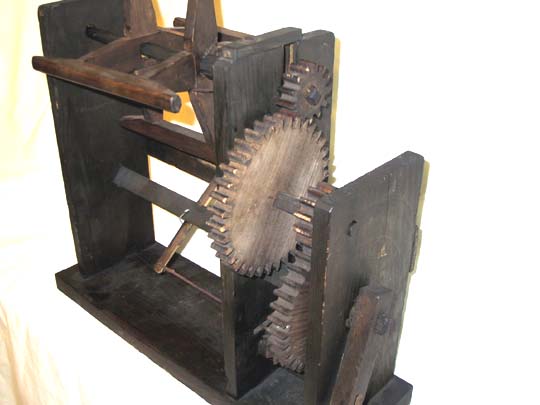
I got this Zakuri on Ebay a couple of years ago. They are occasionally offered there, and also sometimes found in antique markets. I am very fortunate that all the gearing is intact; this is often broken or partially missing.
The Zakuri is a Japanese silk reel with interchangeable bobbins, which are called Itomaki. They were produced in large numbers toward the end of the Edo period (1603 - 1867) in order to encourage cottage industry silk reeling in Japan. They are known as sedentary, or seated, reeling machines.
I've made this thorough set of measurements in order to share the machine with some wood-working friends. If you are interested in making a woodworker's plan, or creating a reproduction of the machine, and need additional measurements or photos, please let me know!
There are two chief benefits of the silk reeler which set it apart from earlier small portable reels. The accelerated bobbin allows the reeler to wind more silk with less cranking, and the bobbins can be taken off to facilitate winding off the silk. The rocker arm lays the silk onto the bobbin in an eccentric pattern, which keeps it from tangling or gluing to itself with sericin.
The base:
The base is a plank of some slightly softer wood 17 5/8" by 5 5/8", and exactly an inch thick, not the thickness of a one-by these days. I can mark this board with my thumbnail, like pine or poplar. It's all stained quite dark except for the bottom of the base, where the natural color shows.
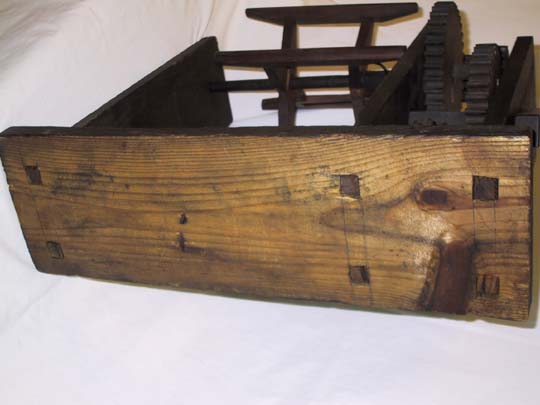
from the left: 3/4" space, then the ends of the uprights which are tenoned in to the base, and are 5/8" across. Then, 3 1/8" to the next set of uprights. The far upright is exactly an inch in from the edge. The score marks are quite clear for the layout; they look more like ink than pencil.
The uprights, starting from the gear end:
The first one is ten inches tall (shorter than
the other two), 5 1/8" wide. The center hole of the handle is centered
about 5 1/2" from the bottom, and 2" from the left side, as you face
the geared end. It's hard to measure, because the handle is in the
way. The other pivot that goes through this upright is in the upper left corner;
it is 1 1/8 from the top, and just a fraction more than that from the left.
The end of the axle is 3/8" across. The axle is round on both ends where
it goes into the uprights, but is square in the middle where the gears are mounted.
The second upright, holding the other end of
the gearing:
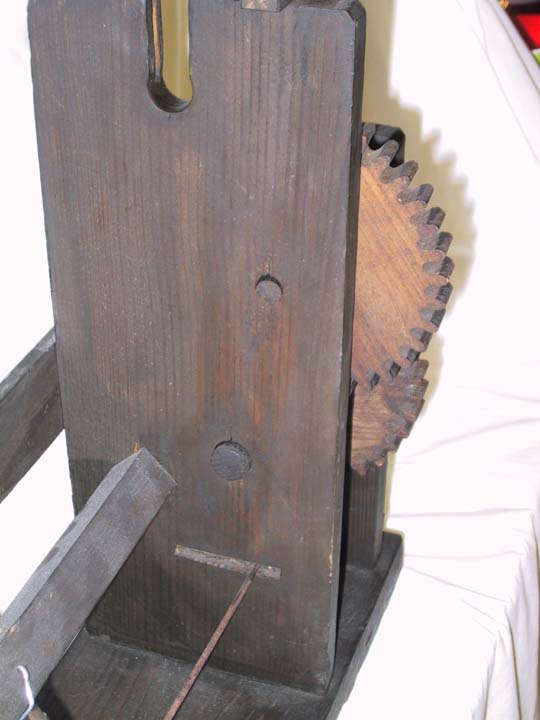
Measurements are taken in the orientation of
this photo - that is, they are backward to the measurements of the other upright.
I am not a draftsman, and they're easier to measure this way. The piece is 5
1/4" across, just slightly wider than the first one,
and 13 1/2" tall (measured above the base board, not to the bottom of the
tenons). 2 3/4" up from the bottom, there is a wide slot that accommodates
the rocker arm guide. The slot is 2" wide, 1/4" tall. It is 1"
from the right hand side, 2" from the left hand side. I know that I'm losing
1/4" in there somewhere. The bar that holds the pivot for the rocker arm
attaches (on center) approximately 4 3/4" up from the base of the upright,
and 1 5/8" over from the left side. The crosspiece that the rocker arm
goes through is 5 1/4" up from the bottom. The large gear pivot (main handle
gear) is centered at 3 1/4" in from the left, 5 3/8" up from the base
of the upright, 1 7/8" from the right edge. The smaller pivot (increasing
gear) is 4" from the left, 1 1/4" from the right, 8 7/8" from
the bottom of the upright. The slot for the bobbin axle is 5/8" wide, rounded
at the bottom, and has a slightly wider inside space. The hole is centered 2
1/2" from the left end and 1 1/2" from the top. A little gate piece
fit in here, round on bottom to fit the axle, but has since been lost. A small
piece of wood, 1/2" by 3/8" by 3 1/8" covers the top of the gate
slot, pivoting on a metal nail one inch from its end.
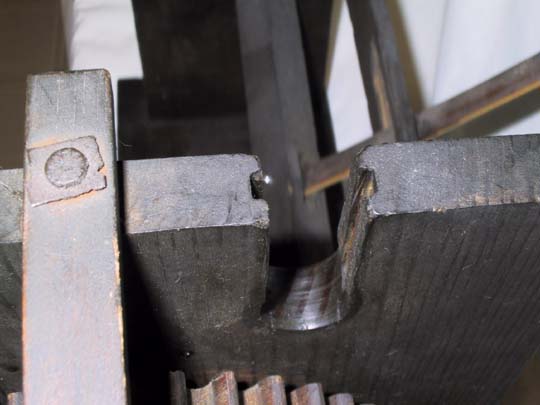
The third upright is measured from the back, which puts it in the same orientation as the middle one. It is 4 1/2" wide, and 13 1/2" tall. It has a hole for the back end of the bobbin axle, which is - centered to match the other end, 2 1/2" from the left, 1 1/2" from the top. The end of the rocker pivot crossbar protrudes through this upright; it is 1 5/8" from the left, 4 5/8" from the bottom, and is 1/4" wide by 3/4" tall.
The cross pieces:
The main large cross piece is 15 3/4" by 1 7/8". It is nailed to the uprights. It is very thin, just over 1/4" thick. There is a slightly ragged slot carved in it, 3 1/4" wide and starting from 8 1/4" from the left end. The slot is distintly angled inside, so that the rocker arm slides back and forth across a flat surface.
The piece that holds the rocker pivot is an inch
square, and a foot long. Both ends are worked down to thin tabs to hold on to
the uprights. There is a slot through which the end of the rocker arm goes,
and the rocker arm is pinned in place. It was not pinned when I got it, and
I used a straightened cotter pin. The slot is 1" wide and a scant quarter
inch top to bottom, and is slightly irregular. The entire piece is set at about
a 45 degree angle, so the slot through it is straight from one side through
to the other, but the rocker arm comes out of it at an angle. You can see it
in http://www.wormspit.com/zakslot.jpg in the
background. I can take a detail shot if needed.
There is a tiny crosspiece between the first and second uprights that holds the rocker arm gear. It is a bugger to measure because of the way it's located down in there, but it's roughly 1/2 thick top to bottom and 1 1/4" wide side to side, and 3 1/4" long side to side if it doesn't go into the upright. It does not protrude through either upright, and I can't see anything hold it in, but I would imagine there's some kind of tenon or peg that doesn't go all the way through the upright but enough to hold it in place. The small gear is pinned on it with a metal nail, I can't get a tape in there to measure the orientation of it, but the meshing of the gears is going to be more important in placing this gear. Mine is actually off-true a little, which makes the rocker arm skip some times.
The axle that holds the handle and the main gear
is bigger than the others. It is 3/4" square in the middle, with a 5/8"
round end that goes through the second upright, and a round part that I can't
measure that goes through the first upright to the handle.
The end of the gear is worked to a tab that goes through the handle support,
and is about 1/4" by 5/8". The handle support is 3/4" deep, 1"
wide, and 5" long. There is a hole where the actual handle went; that was
gone when I got it. I would guess at a round piece with a peg end. The handle
support is made of the same harder wood as the gears and axles. The axle
that drives the bobbin gear is smaller, with the center section being 1/2"
square, and the ends being 3/8" round. It's approximately 5" end to
end, but I can't get right down on it to measure.
Gears:
The gears are of a hard wood, which my friend
Alfred tells me is Zelkova. My best guess would be that a cylinder was turned
and grooved, then sliced to make the gears. The gears have ogee-shaped teeth,
not the angled teeth made by chiseling. All of the gears are the same thickness,
5/8". Eahc gear is mounted onto its shaft, and secured in place with a
tiny sliver of
wood driven through a very small hole. They are really not much more than splinters.
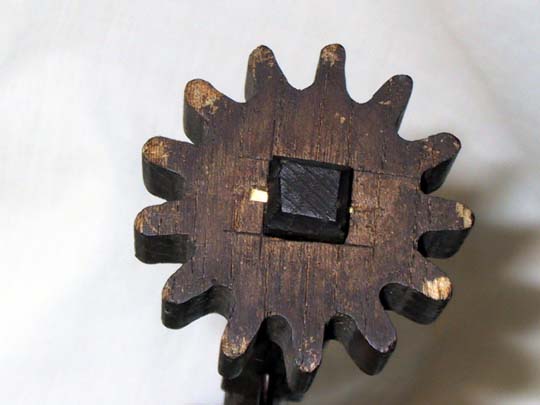
In this photo, you can see the sliver holding the gear in place; I've replaced a missing sliver with one made of a poplar, which shows up bright white.
There are three sizes of gears. The largest is 5 3/8" edge to edge, and has 36 teeth, each 1/2" deep. There are two of this gear; one is attached to the main handle, the other drives the bobbin gear.
There is a middle-sized gear, which is 2 3/8"
across edge to edge and has 15 teeth, each 3/8" deep; it runs the rocker
arm. The rocker arm guide is pinned to the gear near one of its edges (but inside
the radius of the bottom of the teeth) and is just over 7" long. It is
a heavy metal wire, with a small loop over the pin on the gear and a larger
loop through the end of the
rocker arm.
There are two small gears; they are 2' across, with 13 teeth, each of which is 5/16" deep. One of them accelerates the motion from the handle gear to the large gear driving the bobbin, and the other is on the end of the bobbin spindle.
The bobbin spindle is 13 1/4" long. There
is a section at the end, about 3/4" in from the tip, that is the same 5/8"
square, and the gear is mounted onto a tab at the end, similar to the tab the
handle support mounts to. There is a turned round area about
half an inch wide that fits the gated slot. It has a section in the middle that
is square, 5/8", and 3 1/8" long. The remaining 8 1/4" of the
shaft is round, although slightly rough - looks like what you get from a spoke
shave, not a lathe. The tip is smoothed and slightly indented where it rides
in the pivot hole in the third upright, but I can't tell if that's carved
or worn that way. If it's carved, it's a very slight dip. Through the sides
of the bobbin shaft, there is a metal U, five inches long and 2 1/2" wide
at the tips. It is inserted through the shaft about 4" from the end. This
shaft holds the itomaki (bobbin) in place to keep it from rotating or slipping
on the shaft.
The itomaki (bobbin) with this zakuri does not
match in wood color or type with any of the other woods, and appears
to have been made for a different zakuri with a square shaft. I have to use
a rubber band bushing on the bobbin shaft to keep it in place.
The rocker arm is made of bamboo. It is 9" long, 1/2" wide, and a scant quarter inch thick. I have attached a bone button with a piece of wire to guide the thread; it would have had some other form of guide, possibly made of hair, that was not with the machine when I bought it.
One rotation of the main handle makes nearly
three turns of the small gear (36/13, about 2.8) on the accelerating shaft.
The larger gear on the same shaft in turn moves the bobbin's gear (again, 36/13),
so the bobbin turns approx 7.67 times per turn of the handle. Visual inspection
of the mechanism in motion confirms this. The handle gear turns the medium rocker
arm
gear at a slightly lower rate (36/15, or about 2.4), which causes it to wind
on to the bobbin at an eccentric rate. The eccentric wind-on is crucial to the
performance of the machine; it makes the silk wrap onto an area that does not
have a wet parallel strand right below it, so the strands don't stick. One full
revolution of the rocker gear takes the rocker arm
from left to right and back to the left again. So one full turn of the handle
cranks the bobbin around 7.67 times, and takes the rocker from left to right,
right to left, left to right, right to left, and almost halfway back across.
I think that's about everything that I can measure. I've gone back over the descriptions to make sure they make sense, but it's three in the morning now, so if I've missed something, or if a measurement just sounds wrong, please feel free to ask.
The photos below are of zakuris owned by other people. First, this one belongs to my friend Alfred:
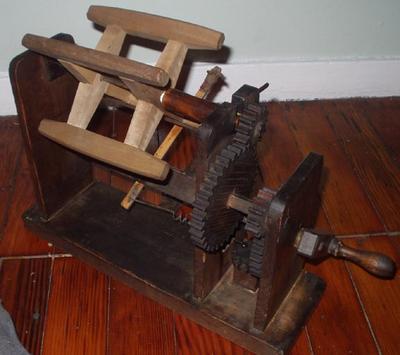
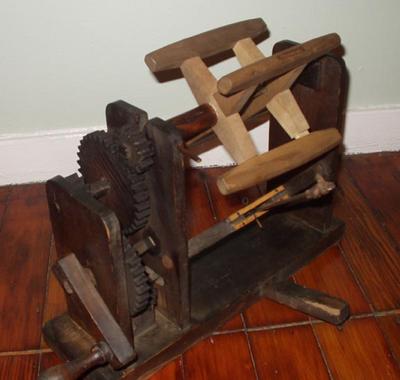


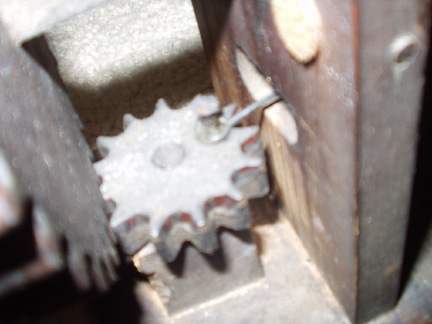
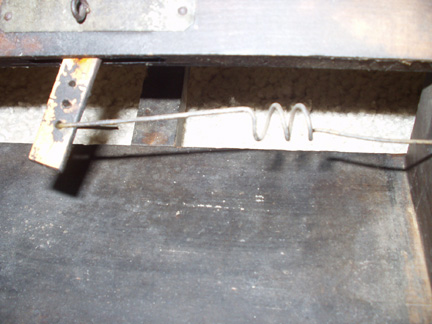
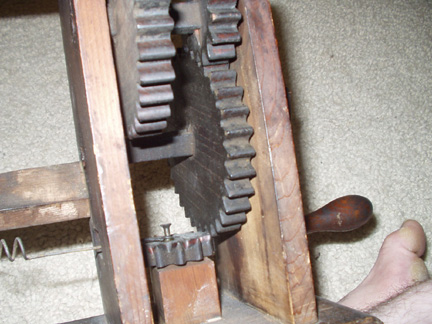
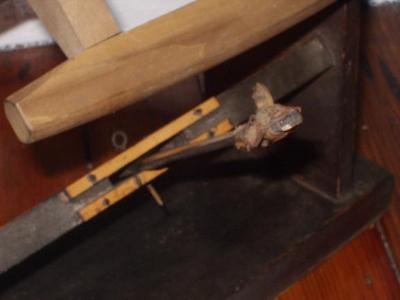
Alfred's zakuri seems to be a little more sturdily built than mine, and has a couple of innovations that I like: the rod that drives the rocker arm (which has a curly springy part) has different slots to hook into, which can change the width of the wrap; also, the rocker arm has a more sturdy setup on the part where it passes through the support. Alfred's appears to be made from a harder wood for the main structural members. The shaft that the bobbin rides on is steel.
This zakuri was offered for sale on an online site. The main difference from the others is that it makes TWO bobbins at once!
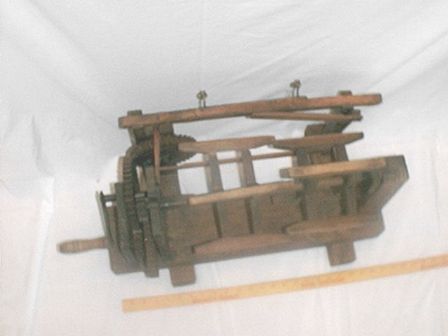
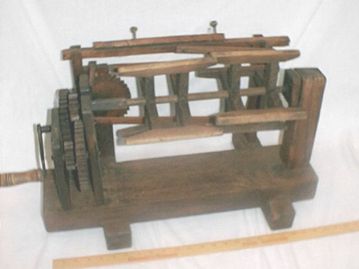
I don't have additional closeups of this one.
There are additional types of the zakuri; some have a slotted cam that drives the rocker arm, and some are entirely belt-driven in place of the toothed gears.
The Spinning Wheel Sleuth has published two articles on antique Japanese silk reelers; you can write to Florence Feldman-Wood to get a copy of one of the back issues. I was a contributing writer on the second article (in Issue 48: Update - Silk Reelers). The Spinning Wheel Sleuth's page has some detail photos of other silk reels.